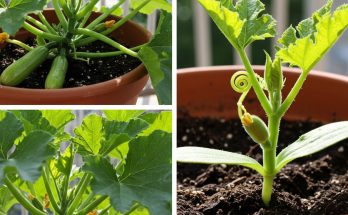Onions are among the easiest and most rewarding vegetables to grow at home, whether in open ground, raised beds, or containers. However, to get a bountiful harvest of large, healthy bulbs, the first few days after sprouting are crucial. What you do at this early stage can greatly influence the final result. Below are essential steps and tips to follow immediately after your onions sprout.
1. Thin the Seedlings Promptly
One of the most important tasks after onion seedlings sprout is thinning. When onions are sown directly in soil, they often come up densely packed. If the seedlings are too close together, they will compete for light, nutrients, and space, which can lead to weak and undersized bulbs.
What to do:
Once the green shoots are about 2–3 inches tall, gently thin them out so there’s at least 1–2 inches of space between each plant. If you’re growing larger varieties, aim for even more space—up to 4 inches between plants. The removed seedlings can be used like chives in the kitchen.
2. Ensure Proper Light Exposure
Onion seedlings need full sun to grow strong. If they’re not getting at least 6–8 hours of direct sunlight daily, they may become leggy and weak.
What to do:
If you’re growing onions indoors or in a greenhouse, rotate trays or containers regularly to ensure even light distribution. Outdoors, make sure they’re not shaded by larger plants or structures.
3. Water Carefully
Young onion plants are delicate and can rot easily if overwatered, yet they also suffer quickly from drought. The key is to keep the soil moist but not soggy.
What to do:
Use a gentle watering method (like a watering can with a fine rose or a hose with a mist setting) to avoid washing away the small seedlings. Water when the top inch of soil feels dry. In hot or windy weather, check daily.
4. Trim the Tops (Optional but Helpful)
Some gardeners like to trim the tops of young onion seedlings to prevent them from becoming too long and floppy. This encourages stronger root development and helps the plants grow more upright.
What to do:
Using clean scissors, snip the tops of the seedlings back to about 3 inches. This can be repeated every week or so until you’re ready to transplant them (if growing in trays) or until the stems grow thicker and more stable.
5. Fertilize Lightly
Young onion seedlings benefit from a mild nutrient boost to encourage leaf and root development. However, too much nitrogen early on can cause rapid green growth at the expense of bulb formation later.
What to do:
After sprouting, apply a diluted balanced liquid fertilizer (such as 10-10-10 or similar) once every 10–14 days. If using organic methods, a seaweed extract or compost tea can provide gentle nourishment.
6. Control Weeds Early
Weeds are a major threat to young onions, especially in the early stages. Onions have shallow roots and are poor competitors. Letting weeds take hold can drastically reduce yields.
What to do:
Hand-weed regularly, being careful not to disturb the onion roots. A shallow hoe can also be used, but work gently to avoid uprooting seedlings. Applying a light mulch, such as straw or fine compost, can help suppress weeds and maintain soil moisture.
7. Watch for Pests and Diseases
Even in the early stages, onions can fall victim to pests like onion maggots, thrips, and fungal diseases like damping off.
What to do:
Inspect the seedlings daily for any signs of trouble. Yellowing leaves, stunted growth, or a mushy base could indicate disease. Avoid overhead watering, ensure good air circulation, and remove any affected plants promptly. For pest issues, neem oil or insecticidal soap can be used as a gentle, plant-safe treatment.
8. Prepare for Transplanting (If Applicable)
If you started your onions indoors or in modules, they’ll eventually need to be moved to their final growing spot.
What to do:
Begin hardening off the seedlings by placing them outside in filtered sunlight for a few hours a day, gradually increasing the exposure over a week or two. Transplant once the plants are about the thickness of a pencil and the risk of frost has passed in your region.
Final Thoughts
Caring for onion seedlings in the days and weeks immediately after sprouting sets the stage for a healthy crop. By thinning properly, managing water and light, feeding lightly, and staying ahead of weeds and pests, you give your onions the best possible start. With a little attention early on, you’ll be well on your way to harvesting plump, flavorful onions by the end of the season.

